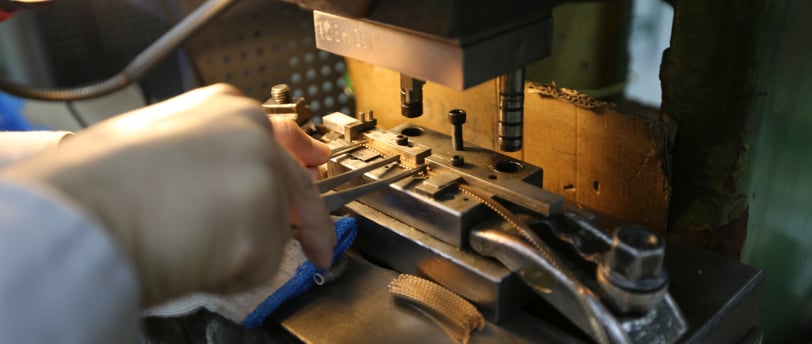Common Stamping Mold Failures and Their Solutions
1/25/2025


Understanding Stamping Mold Failures
Stamping molds are essential tools utilized in various manufacturing processes, particularly in metalworking, to shape and cut materials into specific forms. They are deployed in industries ranging from automotive to electronics, where precise dimensions and intricate designs are necessary. These molds can be classified into several types, including progressive dies, compound dies, and transfer dies, each serving distinct purposes based on the manufacturing requirements.
The materials used for constructing stamping molds play a critical role in their performance and durability. Common materials include steel alloys, tungsten carbide, and aluminum, each offering varying levels of hardness, flexibility, and resistance to wear. The choice of material directly affects how well a mold can withstand the forces applied during the stamping process. However, these molds are not immune to failures, which can severely impact production efficiency and product quality.
Among the prevalent causes of stamping mold failures, design flaws are often at the forefront. Inadequate initial design can lead to imbalances or insufficient support, which may compromise the mold’s integrity during operations. Additionally, over time, materials can degrade due to factors such as exposure to harsh chemicals or extreme temperatures, leading to diminished performance and eventual failure. Wear and tear resulting from repetitive use is another significant factor, as even the most robust molds can succumb to fatigue after extensive periods of operation.
Understanding these common vulnerabilities associated with stamping molds provides a foundation for recognizing potential issues in manufacturing workflows. By investigating the underlying causes of mold failures—whether they stem from design inadequacies, material limitations, or operational wear—manufacturers can better implement necessary reforms to enhance mold longevity and efficacy. This lays the groundwork for exploring viable solutions to mitigate these failures in later sections.
Identifying Common Types of Stamping Mold Failures
Stamping molds are integral components in manufacturing processes, enabling the production of high-precision parts across various industries. However, they are not impervious to failures. Understanding the common types of stamping mold failures can empower manufacturers to identify and address issues proactively. One prevalent failure type is cracking. This defect typically occurs due to excessive stress or improper material selection. Cracks can propagate over time, leading to significant operational disruptions if not detected early.
Another type of failure is deformation, which refers to a permanent change in the shape of the mold. This may arise from extreme temperatures during the stamping process or improper cooling techniques. Deformed molds can compromise the dimensional accuracy of the stamped parts, rendering them unusable and necessitating expensive rework or new tooling.
Improper fits are also a frequent source of failure in stamping molds. These issues can manifest when the mold components do not align correctly, leading to misalignment in the stamping process. This misfit can result in poor part quality, inconsistencies, and increased wear on the equipment. Effective alignment checks during setup can mitigate this concern, ensuring that components fit seamlessly together.
Galling is yet another significant problem that often plagues stamping operations. It occurs when there is excessive friction between the mold surfaces, which can lead to material transfer, wear, and ultimately, surface damage. The presence of galling may render the mold unusable, necessitating repairs or replacements. Utilizing appropriate lubrication and selecting compatible materials can greatly reduce the risk of galling.
In summary, recognizing these common types of stamping mold failures—cracks, deformation, improper fits, and galling—facilitates informed decision-making. Proactive identification and management of these issues can enhance equipment lifespan and improve manufacturing efficiency.
Root Causes of Stamping Mold Failures
The effectiveness and longevity of stamping molds can be significantly compromised by various underlying factors that may lead to operational failures. One of the primary contributors is poor maintenance, which can result in wear and tear that goes unaddressed. Regular inspections and servicing of molds are essential for identifying early signs of wear, lubrication issues, or misalignments, which could escalate into more severe problems if left unattended.
Incorrect setups during the initial stages of stamping can also act as a catalyst for mold failures. Ensuring that molds are properly aligned and set up according to the specifications is crucial. Any deviations in setup can lead to uneven pressure distribution or improper material flow, ultimately resulting in defects or the breakdown of the mold. Operator error, whether stemming from inadequate training or lack of attention, similarly plays a role. Skilled operators are essential for executing stamping processes effectively and minimizing the likelihood of failures.
Furthermore, external conditions such as temperature and humidity can adversely affect stamping operations. High humidity can lead to increased moisture content in the materials used, while extreme temperatures can cause thermal expansion or contraction, affecting mold precision. It is imperative to create an optimal working environment to mitigate these risks. Lastly, the choice of materials used in the stamping process is a fundamental aspect often overlooked. Selecting high-quality materials designed specifically for stamping applications may enhance mold performance and longevity, reducing the occurrence of failures.
By understanding these root causes, practitioners can adopt preventive measures to mitigate the risks associated with stamping mold failures. Consistent maintenance, rigorous setups, operator training, climate control, and judicious material selection are vital components in ensuring that stamping molds remain reliable and efficient throughout their lifecycle.
Effective Solutions and Preventive Measures
Addressing the challenges posed by stamping mold failures requires a comprehensive approach that involves several key strategies. One of the foremost solutions is focusing on mold design. Optimizing the design for durability and ease of maintenance can significantly reduce the likelihood of failures. This includes ensuring adequate material thickness, proper venting, and utilizing designs that allow for easy heat dissipation to maintain consistent temperatures throughout the stamping process.
Regular maintenance schedules are essential to preventing mold failures. Implementing a routine check that includes inspecting wear parts, lubricating moving components, and cleaning mold surfaces can greatly enhance the mold's lifespan. It is also advisable to document maintenance activities and mold performance over time, allowing for the identification of potential issues before they escalate into more significant failures.
Operator training plays a crucial role in the success of any stamping operation. Ensuring that operators understand the intricacies of the stamping process, the significance of molds, and how to operate machinery efficiently can mitigate the risk of human error, which is a common cause of mold failures. Regular training and assessments can help reinforce best practices among operators, leading to more consistent production quality.
The choice of materials used in stamping molds cannot be overlooked. High-quality materials offer superior durability and resistance to wear and tear, ultimately leading to fewer mold failures. Investing in advanced materials can pay dividends in terms of reliability and performance. Additionally, staying abreast of new technologies is vital. Innovations such as 3D printing and advanced simulation software are revolutionizing mold design and production, offering excellent solutions for reducing the incidence of mold failures. By incorporating these technologies, manufacturers can significantly enhance their stamping processes, ensuring greater efficiency and reliability.
